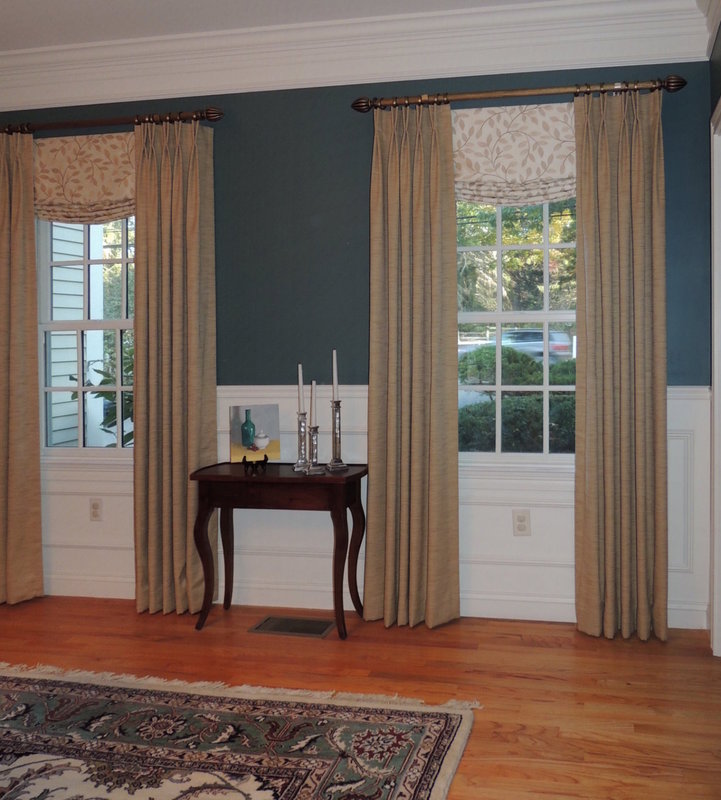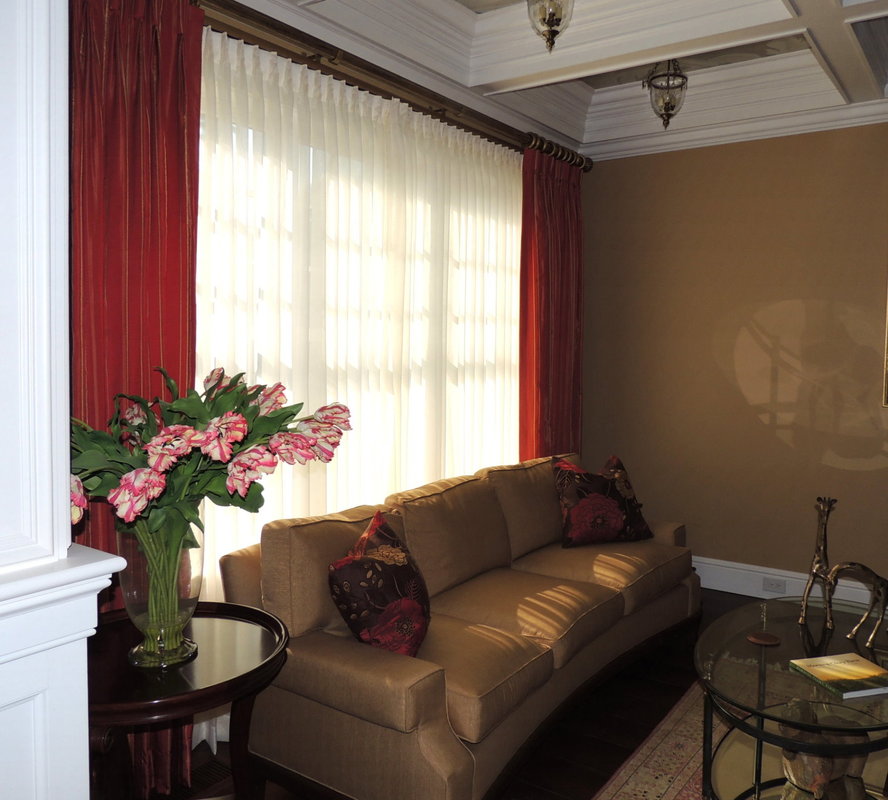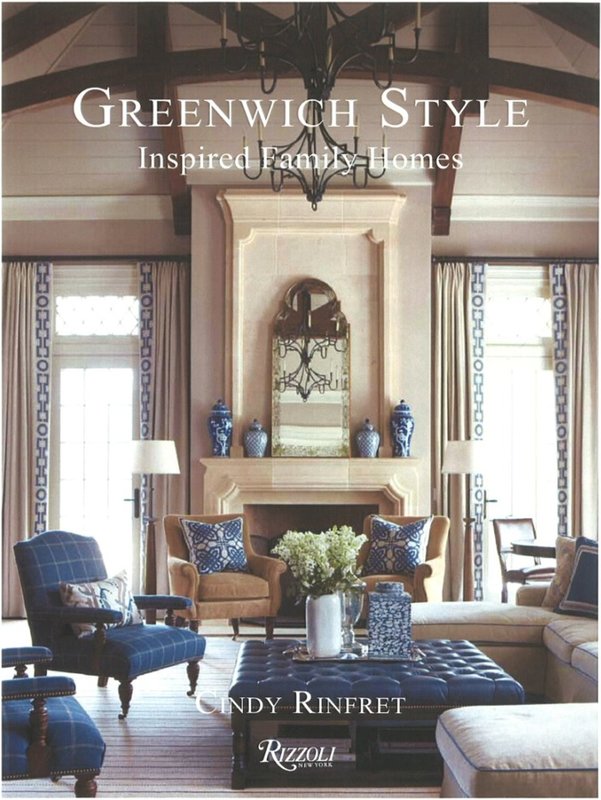|
Today’s blog is about window treatments, specifically drapery panels. While draperies and window treatments are my passion (what better way to showcase gorgeous fabrics?!), and a large percentage of my business, I don’t think that I’ve specifically addressed the trade lingo and facts about draperies in my blog yet. Well, it’s high time! Draperies are a classic and current decorating medium to control light, soften a room, and well, finish it completely and perfectly. As stated by Erin Gates, Boston Interior Designer, author of Elements of Style and her own line of area rugs by Momeni and other beautiful home décor products: “Nothing makes a room look more polished and finished than custom tailored window treatments.” Erin Gate Erin is so right, and regularly features tailored, crisp, and elegant drapery panels in her design projects. So here’s a quick tutorial on the terminology of drapery panels: Stationary Panels: Draperies that are not specifically designed to close fully over the window, but hang at the sides of the window in their “as-designed” configuration. Stationary panels serve to add color, interest, and a soft edge to window and are often layered over a privacy shade or sheers that cover the window. Here's a photo of a dining room I designed with stationary panels layered over relaxed roman shades. I used the butterfly pleat (2-prong) to give some interest to the textured fabric, and the panels hang about ¼” off the floor. No high-water panels in the custom realm! I just love that deep teal color on the walls (Benjamin Moore 2123-20 Caribbean Teal), and this dining room has a Chinoiserie vibe that complements the artwork (not shown) selected by the owner on a trip to Hong Kong. Operable Panels: As the name implies, operable panels are wide enough to be drawn across the window and close over the glass area if desired. Operable panels might be hung via rings that slide on a rod, or a traversing rod system which has a rope loop to pull at the side. The width of the window, and the width of the “stack back” area (to each side of the window), determines the amount of material needed to cover the window for operable panels. Often, we have operable sheers and stationary side panels, as shown below. Fullness: Fullness refers to how much fabric is incorporated in each pleat. 2.5x fullness is fairly standard, meaning that when pleated up at the header, a width of fabric that is 50” wide gets pleated into a usable width of 20” at the top. So, if you are covering the window with operable draperies, the 20” is the parameter that will matter in determining how many “widths of material” (WOM) is needed to cover the window. Sheers are often pleated at 3x fullness for a rich elegant look like the above photo. It doesn’t make sense to do skimpy with custom! Like your mother told you, if you put in the effort to do custom, you do it right. Custom: Well, I don’t need to educate you on what custom means in general, but for window treatments, custom is clearly obvious at first glance. They fit! And they’re proportional! And the quality craftsmanship is visible……. In addition to my other business memberships, I’m a member of the Window Covering Association of America (WCAA), a national organization whose mission is to promote the professional education and standards in the window coverings industry. If you’re interested in the details of what truly constitutes custom fabrication techniques, here’s the area of the WCAA website that shares the standards in our industry: http://www.wcaa.org/industry-standards To summarize the WCAA standards that set custom draperies apart from ready-made, here are the top 5 differences: 1) Lining: Quality lining that hangs separately from the main fabric, and is hemmed. Quality lining is readily apparent at first inspection. It does so much for any window treatment. When one considers that quality lining differs by only $10 total PER PANEL over a thin, ready-made panels, it’s a no-brainer to use quality. After all, you are going to have your custom window treatments a long time. 2) Pattern Match: Patterned fabric is matched at seams, seams are hidden as much as possible, and the pattern must be consistent at the header across multiple treatments/panels in the same room. Custom workrooms like Center Stage (ME!) put particular effort into pattern placement for optimal effect. For more information on “pleating to pattern,” another custom technique, see my prior blog post. 3) Weighted hems and double fold side seams: Weights are inserted in the hems to help the draperies hang straight and correctly. Custom draperies have side hems that are folded over, not “pillowcased” like ready-mades. These side hems serve to keep the draperies from “hiking up” at the edges. Like you, we like “even, level, and smooth.” 4) Interlined if silk or delicate fabric: Interlining is a cotton flannel fabric that marries well to light gossamer fabrics like silk that need more substance when made up into drapery panels. Therefore, silk panels from the Center Stage workroom have three layers: silk, interlining, and cotton sateen lining. Plus, I always insert interlining in the hem of my silk draperies to give some added softness. 5) Banding: Oh, banding is a favorite technique of mine to add luscious umph to drapery panels! Whether with a fabric, or an applied tape/braid, banding is a highly-sought decorative feature that sets custom draperies apart from ready-made, There are many examples of my banded panels in my portfolio area. Below, I share a photo from the cover of Greenwich Style by Cindy Rinfret which shows the incredible decorative power of banded draperies. Finally, here’s an important note on proportion. The proportion of draperies to the architecture of the room and other elements is essential - and exactly what you hire a professional for! This is a large topic that deserves to be addressed separately, so I plan to do that in a future post.
So, that’s all for this week on “The Case for Custom Draperies.” Sounds like a good courtroom drama…well, maybe not so exciting. Suffice to say that custom equals quality, and that’s what Center Stage endeavors to bring to our clients. I hope wherever you are, you are enjoying a lovely and bright Fall day like we have today in Sudbury, MA. Thanks for reading my blog post. If you are reading my blog and enjoying it, or have any comments or topics that you would like me to address, please drop me a line through my contact page. Comments are closed.
|
Barbara PhillipsBarbara Phillips, interior designer and owner of Center Stage Interior Designs, has delivered impeccable window treatments and design services to both residential and commercial clients in Massachusetts since 2001. Categories
All
Archives
March 2021
|





 RSS Feed
RSS Feed